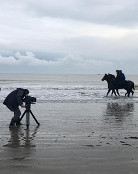Donn's Articles » Trend for change
Trend for change
Trends in racing are usually just trends, embraced by some, derided by others, just another element to factor into your race assessment, if you are so inclined. However, sometimes a trend comes along that is so compelling, it demands more than just a cursory look, it demands examination of the source of the trend and consideration of the need for change to address it. We arrived at that point with the Prix de l’Arc de Triomphe when Danedream scooted clear on Sunday.
Not that the German filly’s victory wasn’t meritorious. When a horse wins a championship race by an easy five lengths, with the race in the bag early in the final furlong, breaking the track record to boot, it is difficult to knock the performance, even if you could have bought her last year for the price of a second-hand Volkswagen Passat.
However, in winning the race, the daughter of Lomitas became the 15th three-year-old to do so in the last 18 years, and the eighth in the last nine. That is a quite incredible statistic for a race that is billed as the championship all-aged middle distance race of Europe, if not of the world.
Often with these headline statistics, there is little depth, but this one is different, this one has depth, with three-year-olds performing consistently well down through the placings. And it isn’t that the Classic generation enjoy a numerical advantage over their elders in the Arc. On the contrary, they are usually in the minority. Only three times in the last 15 years did three-year-olds make up more than half the field: in 1998, when they filled the first four places, in 2000, when they filled the first three places, and in 2004, when they filled the first five.
It is difficult to be certain about the reason for the Classic generation’s dominance, but it is probable that the 8lb that they receive from their elders is hugely influential. It is true that the very best three-year-olds are retired to stud at the end of their Classic season, so that they don’t get a chance to come back the following year and represent the older generation. Four of the last seven three-year-old Arc winners – Dalakhani, Rail Link, Zarkava and Sea The Stars – all departed the racing scene when they left Longchamp’s winner’s enclosure on Arc day.
However, on Sunday, Workforce was the sixth three-year-old Arc winner since 1995 to return to try to defend his crown as a four-year-old, and he was the sixth to come up short. Carnegie, Helissio, Montjeu, Bago, Hurricane Run, Workforce: all top class colts, all high class Arc winners as three-year-olds, all beaten as four-year-olds.
Also, this year, the Classic generation’s challenge appeared to be a little threadbare, weakened by the defection of the Epsom Derby winner and the King George winner, yet still the first two home were three-year-olds.
There has been much debate about the weight-for-age scale this summer, which was probably about time, a century and a half after it was first presented by Admiral Rous. The general consensus seemed to be that the scale as it stands favours three-year-olds, especially over middle distances, from mid-summer on, but probably only by a pound or two.
Weight scales are often tweaked in National Hunt racing. In 2006, when it became apparent that precocious French-breds were becoming a factor, the weight that five-year-olds received from their elders was reduced. When it became obvious that you probably couldn’t win the Grand National off 12st any more, the maximum weight was reduced, and the highweights’ handicap ratings were adjusted.
However, instead of just tweaking the weight-for-age scale on the flat, surely it is now time for a programme of championship races in which all horses carry equal weights. There are very few sports in which, at the highest level, competitors are handicapped. The goal of a championship race should be to determine the fastest competitor, regardless of age or sex. It is remarkable that that is not the case at the highest level of flat racing.
It would be difficult to implement on a global scale at first, but a programme could be put in place at European Pattern level, initially perhaps with the middle distance championship races. You can easily name the races: the Eclipse, the King George, the International, the Champion Stakes in the UK, the Irish Champion Stakes in Ireland, the Arc de Triomphe in France, perhaps the Grosser Preis von Baden in Germany. In time, the programme could be extended to include the mile races, the Sussex Stakes and the QE2, and the sprints.
It would be more difficult for three-year-olds to win one of these races than it is now, of course, but that would mean that only the truly top class sophomores would prevail, and that could only be good for racing and for breeding.
We don’t know for sure if Sea The Stars would have won the 2009 Arc with 8lb more on his back, or if Zarkava would have won the 2008 renewal with 11lb more, but we should. Hopefully, when another Sea The Stars or Zarkava comes along, we will.
© The Racing Post, 4th October 2011


 Follow Donn
Follow Donn